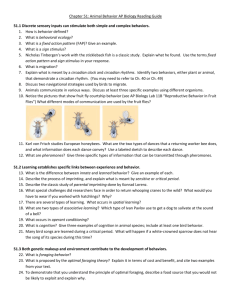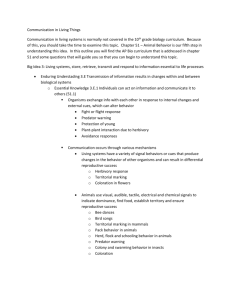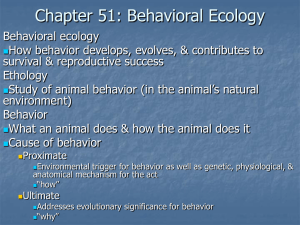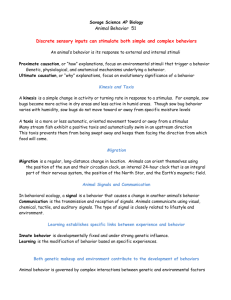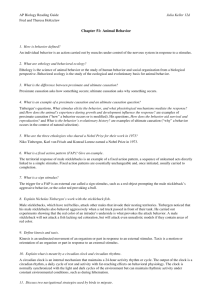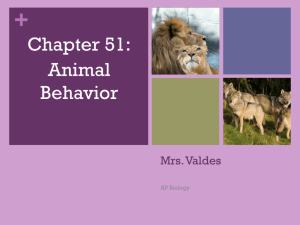Document
advertisement
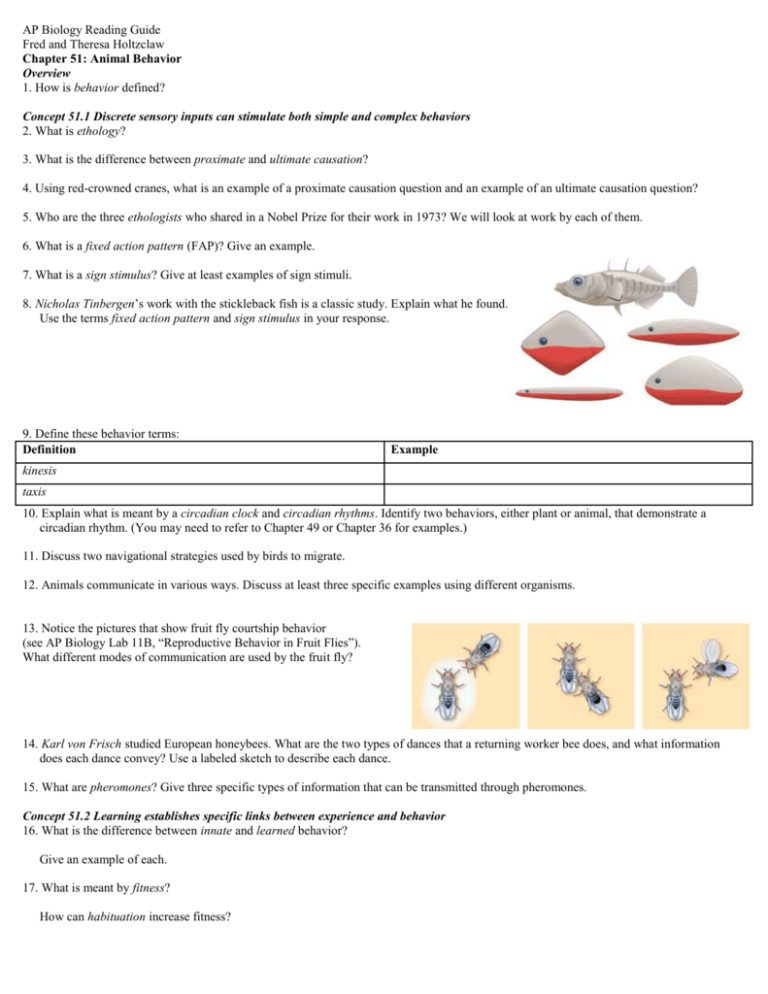
AP Biology Reading Guide Fred and Theresa Holtzclaw Chapter 51: Animal Behavior Overview 1. How is behavior defined? Concept 51.1 Discrete sensory inputs can stimulate both simple and complex behaviors 2. What is ethology? 3. What is the difference between proximate and ultimate causation? 4. Using red-crowned cranes, what is an example of a proximate causation question and an example of an ultimate causation question? 5. Who are the three ethologists who shared in a Nobel Prize for their work in 1973? We will look at work by each of them. 6. What is a fixed action pattern (FAP)? Give an example. 7. What is a sign stimulus? Give at least examples of sign stimuli. 8. Nicholas Tinbergen’s work with the stickleback fish is a classic study. Explain what he found. Use the terms fixed action pattern and sign stimulus in your response. 9. Define these behavior terms: Definition Example kinesis taxis 10. Explain what is meant by a circadian clock and circadian rhythms. Identify two behaviors, either plant or animal, that demonstrate a circadian rhythm. (You may need to refer to Chapter 49 or Chapter 36 for examples.) 11. Discuss two navigational strategies used by birds to migrate. 12. Animals communicate in various ways. Discuss at least three specific examples using different organisms. 13. Notice the pictures that show fruit fly courtship behavior (see AP Biology Lab 11B, “Reproductive Behavior in Fruit Flies”). What different modes of communication are used by the fruit fly? 14. Karl von Frisch studied European honeybees. What are the two types of dances that a returning worker bee does, and what information does each dance convey? Use a labeled sketch to describe each dance. 15. What are pheromones? Give three specific types of information that can be transmitted through pheromones. Concept 51.2 Learning establishes specific links between experience and behavior 16. What is the difference between innate and learned behavior? Give an example of each. 17. What is meant by fitness? How can habituation increase fitness? 18. Describe the process of imprinting, and explain what is meant by sensitive or critical period. 19. Describe the classic study of parental imprinting done by Konrad Lorenz. 20. What special challenges did researchers face in order to return whooping cranes to the wild? What would you have to wear if you worked with hatchlings? Why? 21. There are several types of learning. What occurs in spatial learning? 22. What are two types of associative learning? Which type did Ivan Pavlov use to get a dog to salivate at the sound of a bell? 23. What occurs in operant conditioning? 24. What is cognition? Give three examples of cognition in animal species; include at least one bird behavior. 25. Many bird songs are learned during a critical period. What will happen if a white-crowned sparrow does not hear the song of its species during this time? Concept 51.3 Both genetic makeup and environment contribute to the development of behaviors 26. Based on cross-fostering and human twin studies, what are the two factors that contribute significantly to behavior? 27. This concept looks at some very interesting ways that genetic changes affect behavior. Several important case studies that show a genetic component to behavior are presented. Take time to read and enjoy them. The study of voles and their mating behaviors is often discussed in other science articles. To return to fruit fly mating, a single gene called fru controls male mating behavior. If males lack a functional fru gene (short for fruitless), what happens? And what occurs if females are genetically manipulated to express this gene? Concept 51.4 Selection for individual survival and reproductive success can explain most behaviors 28. What is foraging behavior? 29. What is proposed by the optimal foraging theory? Explain it in terms of cost and benefit, and cite two examples from your text. 30. To demonstrate that you understand the principle of optimal foraging, describe a food source that you would not be likely to exploit. 31. Explain each of these mating systems: promiscuity monogamy polygamy polygyny polyandry 32. Explain two factors that may be important in determining the evolution of these systems, and apply each factor to a particular species. 33. Let’s return to an earlier idea. What is sexual selection? (Chapter 23) 34. There are two types of sexual selection. Explain each of them. intersexual selection intrasexual selection 35. What is agonistic behavior? Give one example of this behavior that is not in your book. Concept 51.5 Inclusive fitness can account for the evolution of altruistic social behavior 36. What is altruism? 37. Explain the evolutionary advantage to a population of having members who exhibit altruistic behavior. 38. Altruism may reduce the fitness of an individual—for example, by making that individual more obvious to a predator. Explain this behavior using the concept of inclusive fitness. 39. Explain the logic behind geneticist J.B.S. Haldane’s comment that he would lay down his life for two brothers or eight cousins. 40. Contrast kin selection and reciprocal altruism.
